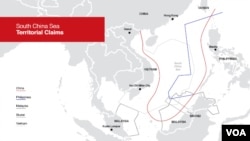The Chinese Navy has seized a U.S. naval underwater drone from international waters in the South China Sea.
The Pentagon has used diplomatic channels to call for the immediate return of the unmanned ocean glider and to ask that China not repeat these types of incidents. Although unmanned, the glider still retains the protections of a sovereign U.S. vessel.
“This is an action that’s not in keeping with international law,” Pentagon spokesman Navy Capt. Jeff Davis said. “It’s certainly not something we consider to be commensurate with [China’s] level as a professional military.”
Davis told reporters a civilian-manned Navy oceanographic research vessel was in the process of recovering two underwater ocean gliders that were “stopped dead in the water” about 93 kilometers from U.S. Naval Base Subic Bay in the Philippines when a Chinese military vessel approached Thursday.
The Chinese DALANG-III Class ship, hull number ASR-510, dispatched a smaller vessel into the water and snatched one of the unmanned gliders as the U.S. Navy ship was retrieving the other one.
“There were multiple attempts over bridge-to-bridge radio to demand it back,” said Davis. “[The Chinese Navy] acknowledged the communications on bridge-to-bridge radio, so it wasn’t a radio problem, but ignored the requests for it to be returned,” he added.
Davis said the Chinese gave no reason for taking the U.S. underwater drone, which he said has a retail value of about $150,000. As the Chinese vessel was leaving, the only communication its crew sent to the U.S. Navy ship was, “We are returning to normal operations,” according to Davis.
The Pentagon says the glider drone measures unclassified information, including water temperature, clarity, salinity, and how fast sound travels through the water.
The bathometric data is gathered to help with sonar use in the water, among other things, and is collected by the U.S. military in international waters across the globe. The two gliders being recovered had run a pre-programmed route and had stopped in the South China Sea’s international waters for a routine recovery mission, according to Davis.





